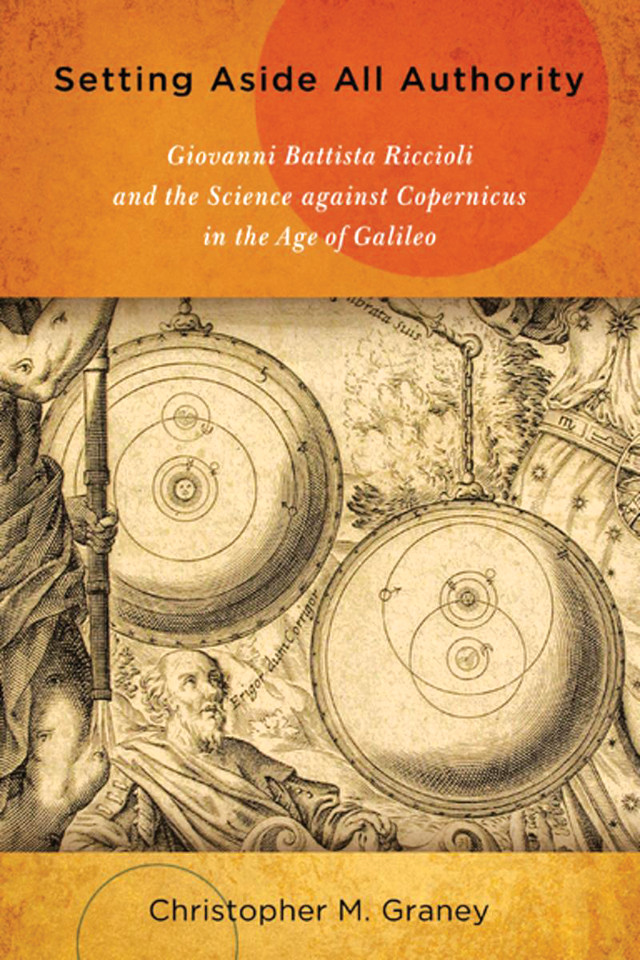
by Jacob Haqq-Misra Tuesday, July 3, 2018

"Setting Aside All Authority: Giovanni Battista Riccioli and the Science Against Copernicus in the Age of Galileo" by Christopher M. Graney, University of Notre Dame Press, 2015, ISBN: 978-0-268-02988-3
Galileo’s commitment to Copernican cosmology — with Earth orbiting the sun — despite his 17th-century inquisition and imprisonment by Roman Catholic authorities remains a pivotal moment in the history of modern physics and astronomy, and in the history of tension between science and religion. Though today we take the fundamentals Galileo espoused for granted, in his day, the scientific debate among proponents of different celestial models remained hotly contested.
In “Setting Aside All Authority: Giovanni Battista Riccioli and the Science Against Copernicus in the Age of Galileo,” Christopher M. Graney recounts how scientists of the day tended to rally against Copernicus. Graney specifically highlights the work of astronomer Giovanni Battista Riccioli, who, in 1651, published the “New Almagest,” which became the seminal astronomy reference of its day.
The cover of Graney’s book shows a set of scales weighing the balance between two competing cosmological systems: sun-centric versus Earth-centric. While the Copernican system falls on the sun-centric side, the scales are tipped toward the Earth-centric. Yet, the favored alternative was not the simple Ptolemaic system, with all objects orbiting Earth; instead, Riccioli championed a hybrid model of geocentrism originally developed by Danish astronomer Tycho Brahe.
The Tychonic system kept Earth at the center of the “universe” (the solar system in modern parlance), with the moon and sun in orbit, while the rest of the planets orbited the sun. By Riccioli’s day, the older Ptolemaic system had been discarded due to observations of phases on Venus (which implied that it orbits the sun), but Tycho’s hybrid geocentrism was a compromise between the Ptolemaic and Copernican views. The Tychonic system provided many of the same predictions as the Copernican system, so the distinction between them amounted to whether Earth itself was thought to move in space.
Riccioli’s “New Almagest” updated Tycho’s naked-eye observations and hybrid cosmological model with telescopic data. The Copernicans believed that, with Earth orbiting the sun, the positions of stars should appear slightly different when Earth was at opposite points in its orbit because of the parallax effect. However, parallax had never been observed among the stars up to the time of Riccioli.
Copernicans explained the lack of parallax by proposing that the stars are extremely distant, but a problem remained with the measured diameters of stars: To explain the lack of observed parallax, the stars had to be extremely far away. But then, for them to be bright enough to be seen in the sky, they must also be orders of magnitude larger than the sun — possibly even approaching the size of the known universe for some of the brightest stars in the sky. The only way out for the Copernicans was to invoke the greatness of God. Riccioli remained unsatisfied with this appeal to the divine, and thus became a proponent of the Tychonic system.
The second factor against Copernicanism was the lack of evidence for Earth’s rotation. Tycho suggested that Earth’s rotation should affect the motion of projectiles on large scales. Riccioli reasoned that a cannonball fired northward should show an eastward deflection if Earth rotated, but no such effect had been noticed. Riccioli and others (including Isaac Newton) even experimented with dropping objects from various heights to observe evidence of deflection, but to no avail. With the lack of observable parallax and evidence of Earth’s rotation, the balance tipped in favor of the Tychonic system.
Although the reality of Earth’s rotation and revolution about the sun seems obvious today, Graney’s meticulous historical analysis reminds us that this was far from obvious to Tycho, Galileo and Riccioli — as well as to the Catholic Church that is so often implicated for impeding scientific progress. The church certainly had theological and political motivations, but its support of the Tychonic system might also have been motivated by the scientific consensus of the day.
Graney’s deep knowledge of the era’s astronomical debates partly derives from his own translations of writings by Riccioli and others from their original Latin, which highlight some of the technical discussions among astronomers at the time. The Latin and English translations of these writings are included as appendices, making “Setting Aside All Authority” a valuable read for scholars and armchair historians alike. Riccioli’s model was indeed ultimately superseded by Galileo’s, but his story, as told by Graney, makes for an important case study for all students of the history of science.
© 2008-2021. All rights reserved. Any copying, redistribution or retransmission of any of the contents of this service without the expressed written permission of the American Geosciences Institute is expressly prohibited. Click here for all copyright requests.